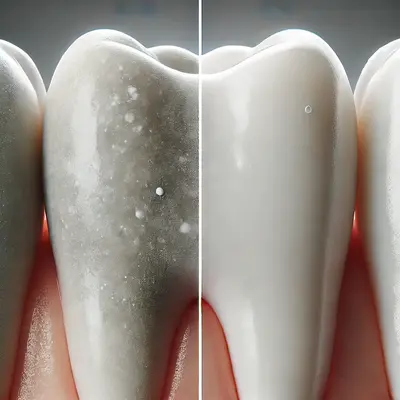Imagine Andrew, a 35-year-old, who noticed his teeth becoming increasingly sensitive to cold drinks. After a visit to the dentist, he learned that his enamel was wearing thin, leaving his teeth vulnerable to decay. Meanwhile, Emily, a mother of two, saw small white spots on her child’s teeth, which the pediatric dentist explained were early signs of demineralization. Both Andrew and Emily were facing the same issue: tooth demineralization. But can you reverse it? The good news is—yes! Through remineralization, you can strengthen your teeth and prevent further damage.
American Dental Association (ADA):
- “Fluoride plays a crucial role in the remineralization process. It attracts calcium and phosphate to the teeth, helping to restore weakened enamel.” — ADA, Fluoride’s Role in Protecting Teeth
National Institutes of Health (NIH):
- “Remineralization can halt the progression of dental caries in the early stages, making it an essential aspect of preventive dental care.” — NIH, Strategies for Remineralizing Enamel
Mayo Clinic:
- “By avoiding acidic foods and incorporating fluoride treatments, patients can naturally enhance the remineralization of their teeth and prevent further decay.” — Mayo Clinic, Preventing and Treating Tooth Decay
World Health Organization (WHO):
- “Oral health education, focusing on the benefits of fluoride use, can significantly increase the population’s knowledge of how to encourage natural tooth remineralization.” — WHO, Oral Health Promotion
Symptom Breakdown: What is Tooth Demineralization?
Tooth demineralization happens when the enamel—the outer protective layer of the teeth—begins to break down. This process occurs when acids from food and bacteria erode minerals like calcium and phosphate from the enamel. Over time, this can lead to cavities and more serious dental problems. Recognizing the early signs is key to starting the remineralization process.
Key Symptoms of Demineralization:
- Increased sensitivity to hot and cold
- White spots on teeth
- Thinning enamel
- Rough or uneven tooth surface
- Early stages of tooth decay
Diagnostic Path: Why Are Your Teeth Losing Minerals?
Understanding what contributes to demineralization is essential for knowing how to stop and reverse it. A dentist may look at the following factors when diagnosing the issue:
- Diet:
Consuming a diet high in sugar and acidic foods can create a more acidic environment in the mouth, which erodes enamel. - Poor Oral Hygiene:
Not brushing and flossing regularly allows plaque to build up, producing acids that wear away the enamel. - Dry Mouth:
Saliva helps wash away food particles and neutralize acids, so a lack of saliva increases the risk of demineralization. - Bruxism (Teeth Grinding):
Grinding your teeth weakens the enamel and can accelerate demineralization. - Medical Conditions:
Acid reflux, bulimia, or medications that reduce saliva flow can also contribute to enamel loss.
Deep Dive: How to Remineralize Teeth Effectively
Remineralization is the natural process of restoring lost minerals to the teeth. By making key lifestyle changes and incorporating the right products into your oral care routine, you can help strengthen your enamel. Here’s how:
- Fluoride Toothpaste:
Using toothpaste with fluoride is one of the most effective ways to remineralize your teeth. Fluoride helps to attract calcium and phosphate ions to the enamel, making it harder and more resistant to acids. - Incorporate Calcium and Phosphorus into Your Diet:
A diet rich in calcium and phosphorus strengthens teeth from the inside out. Foods like dairy products, leafy greens, nuts, and fish are excellent sources of these minerals. - Xylitol Gum:
Chewing gum with xylitol not only stimulates saliva flow but also helps reduce the acidity in your mouth, creating an environment that promotes remineralization. - Remineralizing Agents (e.g., Hydroxyapatite):
Products containing hydroxyapatite—a mineral naturally found in teeth—can effectively fill in demineralized areas and rebuild enamel. - Reduce Acidic Foods and Drinks:
Cut down on foods and drinks that lower the pH in your mouth, such as sodas, citrus fruits, and wine. Opt for water or milk to help neutralize acids.
Treatment Comparison: Effective Ways to Remineralize Teeth
Here’s a look at some of the top methods for remineralizing teeth and how they compare in effectiveness:
| Method | Effectiveness | Key Benefit |
|---|---|---|
| Fluoride Toothpaste | High | Strengthens enamel and prevents cavities |
| Remineralizing Toothpaste | Medium to High | Replenishes lost minerals |
| Xylitol Gum | Medium | Reduces acidity and promotes saliva flow |
| Calcium-Rich Diet | Medium | Naturally strengthens teeth from the inside |
| Reducing Sugary/Acidic Foods | Medium | Prevents further demineralization |
Incorporating several of these methods into your routine ensures the best results for improving your dental health.
Outcome Story: Success Through Remineralization
Let’s look at Jason, a college student who constantly snacked on sugary energy drinks and acidic foods. Over time, his dentist noticed early signs of demineralization. After switching to fluoride toothpaste, reducing his sugar intake, and chewing xylitol gum, Jason saw significant improvements in his enamel. Similarly, Rachel, a 40-year-old office worker, incorporated more calcium into her diet and started using a remineralizing toothpaste, which helped her reverse the early stages of tooth decay.
Start Remineralizing Your Teeth Today
Remineralization is a simple yet powerful way to improve your dental health and prevent future problems. By making small changes—like switching to fluoride toothpaste, eating a mineral-rich diet, and avoiding acidic foods—you can help restore lost minerals and protect your teeth for years to come. Don’t wait until it’s too late; start your remineralization journey today.






